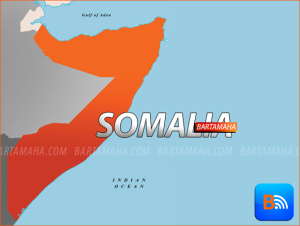How ALSHABAAB Lost Control of Somalia
 On Wednesday, the African Union Mission in Somalia, a multi-national military force, first deployed in 2007 to support the country’s besieged Transitional Federal Government, warned civilians in Kismayo that the mission’s final assault on their city was imminent. Kismayo is the last major town controlled by the Islamist militant movement al Shabaab, the al Qaeda-affiliated group that ruled much of Somalia until Aprilof this year. Although Kismayo has been the site of U.S. drone attacks, its port still does a brisk business in sugar cane imports and charcoal exports. Tres Thomas, a Somalia analyst and PhD candidate at George Mason University, estimates that the port makes al Shabaab “tens of millions of dollars” a year and is the group’s “most lucrative source of internal revenue.” So Kismayo’s possible fall is a big deal for the future of a particularly destabilizing terrorist insurgency. But how big?
On Wednesday, the African Union Mission in Somalia, a multi-national military force, first deployed in 2007 to support the country’s besieged Transitional Federal Government, warned civilians in Kismayo that the mission’s final assault on their city was imminent. Kismayo is the last major town controlled by the Islamist militant movement al Shabaab, the al Qaeda-affiliated group that ruled much of Somalia until Aprilof this year. Although Kismayo has been the site of U.S. drone attacks, its port still does a brisk business in sugar cane imports and charcoal exports. Tres Thomas, a Somalia analyst and PhD candidate at George Mason University, estimates that the port makes al Shabaab “tens of millions of dollars” a year and is the group’s “most lucrative source of internal revenue.” So Kismayo’s possible fall is a big deal for the future of a particularly destabilizing terrorist insurgency. But how big?
The port city is more than a financial engine for al Shabaab, which has recruited and trained terrorists from around the world, and which national security analyst Daveed Gartenstein-Ross once characterized as “a significant security concern to several countries, including the United States.” The city is also the last bastion of an organization that once threatened to create an Afghanistan-like safe haven for piracy and terrorism, an Islamist militia with the ability to destabilize both its neighbors and globally significant shipping lanes in the Gulf of Aden. As recently as early 2012, al Shabaab controlled most of the capital city of Mogadishu. Now, al Shabaab may be nearing the end of its rule over Somalia. Reuters cited “Western diplomats” predicting that the group will continue its terror attacks and bombings within Somalia. But, for Somalia, this could be the end of a very dark era.
As Jeremy Scahill argued in a 2011 report for The Nation, al Shabaab’s rise was partially a reaction against perceived U.S. meddling in Somalia in the wake of September 11, 2001, after which the Bush administration armed and empowered local warlords in order to curb terrorist activity. Ironically, foreign intervention has also contributed to the group’s decline: in October 2011, Kenya launched a military incursion into southern Somalia, a supposed mission of self-defense against kidnappings inside Kenya and continued instability along the country’s northern border. At the same time, the Ethiopian military had been fighting al-Shabaab in western Somalia — a legacy of the 2006 invasion that helped dislodge the Islamic Courts Union, an al Shabaab precursor that briefly controlled Mogadishu.
How did this group of extremist Islamist militants end up controlling much of the southern half of Somalia, a country roughly the same size as France? E.J. Hogendoorn, Horn of Africa project director for the International Crisis Group, told me that al Shabaab’s control of Somalia was never wholly secure — its rule largely depended on deftly negotiating the country’s highly fraught clan politics. The 2011 invasion by the Kenyan army (a move that the Crisis Group still believes to have been ill-advised) — and the formal mergingof the Kenyan mission with the African Union force in January — threw off Somalia’s military and political balance. “The fact that al Shabaab was attacked along three axes overstretched its conventional military capabilities,” Hogendoorn said. In early 2012, the African Union launched a major offensive against al Shabaab, ejecting the group from Mogadishu that April. “In that campaign, al Shabaab lost a lot of people,” Hogendoorn explained. “And ultimately it appears the Shabaab’s leadership decided it can’t sustain a conventional war with a militarily superior force.”
The turning point may have come when the foreign forces in Somalia started cooperating, Thomas suggested. “I think the catalyst is the actual coordination between Kenya, Ethiopia, the Somali government, AMISOM, and the proxy militias that all of these groups used to combat al Shabaab,” he said. “It’s only recently that they had a coherent and collective vision in terms of how to defeat al Shabaab on the battlefield.” The U.S. has contributed to this effort as well. “The entry of unmanned U.S. drones flying over their positions has somewhat limited al Shabaab’s mobility,” Mohammad Ademo, a journalist, political analyst, and founder of the Horn of Africa-focused website OPride, wrote in an email. And in July, the Daily Beast’s Eli Lake reported on the full extent of American security cooperation with the Somali government, which included the deployment of special forces and the training of intelligence officials.
Militarily, al Shabaab’s defeat seems to have been partly a result of regional and international power politics — of Kenyan and Ethiopian attempts to expand their spheres of influence, and of American efforts to curtail potentially threatening Islamist terror groups. And it was partly a result of a largely unprecedented effort in African multilateralism. As of November of 2011, over 500 soldiers, mostly from Uganda and Burundi, had died in a mission to prop up one of Africa’s most vulnerable governments and to help reverse Somalia’s 20-year trajectory of state failure and anarchy. But al Shabaab’s decline is just as attributable to far more prosaic factors: by all accounts, daily life under the al Qeada affiliate was miserable.
Al Shabaab blocked outside aid groups during the devastating famine of 2011, a move that forced starving Somalis to flee Shabaab-controlled areas if they needed help — and that “led to a withdrawal of public support,” according to Ademo. They imposed what Hogendoorn described as “very draconian Salafi interpretations of what is and is not permitted under Sharia law,” levied high taxes, and impressed local youth into militia service (a 2010 Human Rights Watch report provides a similarly grim assessment of al Shabaab’s rule). Physical security, the bedrock of al Shabaab’s support, began to deteriorate thanks to the group’s “increased deployment of suicide attacks and IED attacks that were yielding high civilian casualties,” says Thomas. At the same time that the African Union, Kenya, Ethiopia and the U.S. were threatening al Shabaab’s military hold on Somalia, much of the country, and, more importantly, many of the clans and local leaders who had sided with al Shabaab, decided they had had enough.
Still, even as African Union forces prepare for their attack on Kismayo, al Shabaab is providing a vicious reminder of just how tenuous this victory could end up being. On Thursday, at least 14 people, including several journalists, were killed in twin suicide blasts in downtown Mogadishu, which is no longer under the group’s control. Abdi Aynte, a reporter for Al Jazeera, tweeted that the attack might have specifically targeted known haunts of Mogadishu’s journalists. As Aynte wrote, this appeared to be an attack on a “soft target” – a means of amassing a body count and instilling fear; a bid at derailing Somalia’s fragile transition.
At this point, al Shabaab might prefer this sort of a campaign anyway. The group has a recent history of tactical retreats, Thomas explained, and has been able to maintain a force of as many as 12,000 fighters partly because “they’ve avoided engagements with forces with better weapons than them.” The fall of Kismayo might not signal al Shabaab’s military defeat so much as its transition into a full-blown terrorist insurgency, dedicated to a bloody, long-term guerrilla war against Somalia’s fledgling government.
On August 20, Somalia swore in its first parliament since 1991; the country inaugurated its newly elected president on September 11. While al Shabaab regroups, the opportunity of this moment, to finally pull Somalia out of chaos, is as urgent as ever. “There is an overwhelming hope and goodwill,” writes Ademo. “Al-Shabaab’s ‘defeat’ offers a unique opportunity for all stakeholders, including Somalis from all walks of life and the international community, to seize this moment and help Somalia rise again. It is a now or never scenario.”
___
The Atlantic
Comments
comments
 Calendar
Calendar





































